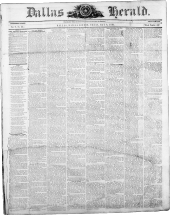June 24, 1863, Dallas Herald
An Act to establish the Flag of the Confederate States.
“The Congress of the Confederate States of America do enact, That the flag of the Confederate States shall be as follows: The field to be white, the length double the width of the flag, with the union (now used as a battle flag) to be a square of two-thirds the width of the flag, having the ground red, with a broad saltier of blue, bordered with white, (a blue cross white edged–Ed. Tel.) and emblazoned with white mullets of five pointed stars, corresponding in number to that of the Confederate States.”
Approved May 1st, 1863.
The above act describes the new flag so that with a little attention our readers can form a just idea of it. We remark merely that a “saltier” in Heraldic language imports the same as the cross of St. Andrew or a diagonal cross–and that “mullets” are five pointed stars.
We are gratified that the flag of the Provisional Congress has been changed, and that the permanent banner of the Confederacy is so entirely different from the old flag. The stars and stripes and stars and bars too nearly resembled each other to symbolize the characteristics of the two Governments; and besides were easily mistaken for each other on the field. This fact induced Gens. Johnson and Beauregard, immediately after the first battle of Manassas to order the use of a battle flag. They selected the design which had been proposed for the Confederate flag by Mr. Miles of South Carolina, when the stars and bars were adopted. Under this battle flag our brave soldiers have been ever since fighting; it had become endeared to them and to the people by the historic associations connected with it on many fields of blood. This flag then must be in some way preserved, and amid the variety of opinions concerning the adoption of a new flag, these considerations had controlling force. The committee on flag and seal determined to make the battle flag a “Union” for the Confederate banner, and a majority recommended a white field with a blue bar extending through it lengthwise. This report was adopted by the Senate, but in the House it was amended on motion of Mr. Gray, who was a member of the Committee, by insertion of a description of the battle flag and striking out the blue bar, thus leaving a pure white field, and this is the flag now adopted for the Confederacy. At Richmond and every where east of the Mississippi it has been received with general satisfaction. Our exchanges all speak of it in complimentary terms. The Richmond Dispatch says:
“The new flag, which was displayed from the capitol on Thursday, it is gratifying to say, gives universal satisfaction. Almost any sort of a flag, to take the place of the detested parody upon the stars and stripes, for so long the lawful ensign of the Confederacy, would have been hailed with pleasure. But the one we now have is not only acceptable on this ground, but on account of its own appropriateness; and more than this, again, because in it is preserved that immortal banner–the battle flag–which has been consecrated on so many battle fields and has been followed by our soldiers to so many glorious victories. We had not anticipated from the action of Congress upon the subject a result so sensible, so generally satisfactory. The councils of many on such a topic rarely produce anything but an abortion, such as the “Stars and Bars!” for instance. Let us have no more of that, but hereafter know only that appropriate and beautiful banner hallowed by our victories and now established by law.”
The President, we learn, approved it with satisfaction–most of the army officers, especially Beauregard, express pleasure at its adoption, and our most prominent naval officers say that it is admirable for its distinctness. They say the white can be seen further at sea than any other, unless the red be an exception. The flag was adopted on the 1st May, the day on which began the late battles at Fredericksburg, Chancellorsville and Wilderness Church, and the first use made of it–its baptism so to speak–was to shroud the remains of the immortal “Stonewall” Jackson.
The symbolism of the flag may be said to be thus: The Confederate States represented by the stars are united in strength on the blue cross, emblematic of faith, and so united are contending on the red ground of blood for truth, peace and freedom, which we tender on the field of white. Thus while we offer peace to all nations, yet united by common faith we are strong, and are ready to battle for truth and freedom.
It is a noble and glorious ensign–scattering all thoughts of reconstruction–and leading to victory and independence.
